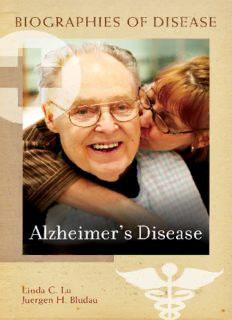
Alzheimer's Disease (Biographies of Disease) PDF
Preview Alzheimer's Disease (Biographies of Disease)
Alzheimer’s Disease Recent Titles in the Biographies of Disease Series Infl uenza Roni K. Devlin ADHD Paul Graves Hammerness Food Allergies Alice C. Richer Anorexia Stacy Beller Stryer Obesity Kathleen Y. Wolin, Sc.D. and Jennifer M. Petrelli Sports Injuries Jennifer A. Baima Polio Daniel J. Wilson Cancer Susan Elaine Pories, Marsha A. Moses, and Margaret M. Lotz Fibromyalgia Kim D. Jones and Janice H. Hoffman Alcoholism Maria Gifford Anxiety Cheryl Winning Ghinassi Thyroid Disease Sareh Parangi and Roy Phitayakorn Alzheimer’s Disease Linda C. Lu and Juergen H. Bludau Biographies of Disease Julie K. Silver, M.D., Series Editor Copyright 2011 by Linda C. Lu and Juergen H. Bludau All rights reserved. No part of this publication may be reproduced, stored in a retrieval system, or transmitted, in any form or by any means, electronic, mechanical, photocopying, recording, or otherwise, except for the inclusion of brief quotations in a review, without prior permission in writing from the publisher. Library of Congress Cataloging-in-Publication Data Lu, Linda C. Alzheimer’s disease / Linda C. Lu and Juergen H. Bludau. p. ; cm. — (Biographies of disease) Includes bibliographical references and index. ISBN 978-0-313-38110-2 (alk. paper) — ISBN 978-0-313-38111-9 (ebook) 1. Alzheimer’s disease. I. Bludau, Juergen. II. Title. III. Series: Biographies of disease. 1940-445X [DNLM: 1. Alzheimer Disease—etiology. 2. Alzheimer Disease—diagnosis. 3. Alzheimer Disease—therapy. WT 155] RC523.L8 2011 616.8'31— dc22 2010041534 ISBN: 978-0-313-38110-2 EISBN: 978-0-313-38111-9 15 14 13 12 11 1 2 3 4 5 This book is also available on the World Wide Web as an eBook. Visit www.abc-clio.com for details. Greenwood An Imprint of ABC-CLIO, LLC ABC-CLIO, LLC 130 Cremona Drive, P.O. Box 1911 Santa Barbara, California 93116-1911 This book is printed on acid-free paper Manufactured in the United States of America Contents Series Foreword vii Preface ix Introduction xi Chapter 1. What Is Alzheimer’s Disease? 1 Chapter 2. What Causes Alzheimer’s Disease? 15 Chapter 3. What Are the Signs of Alzheimer’s Disease? 27 Chapter 4. How Is Alzheimer’s Disease Diagnosed? 39 Chapter 5. How Is Alzheimer’s Disease Treated? 59 Chapter 6. The Course and Complications of Alzheimer’s Disease 79 Chapter 7. How Does Alzheimer’s Disease Affect the Family and Caregivers? 89 Chapter 8. Scientifi c and Clinical Research in Alzheimer’s Disease 103 vi Contents Appendix A. Narratives 111 Appendix B. Timeline 123 Appendix C. 10 Useful Web Sites 127 Glossary 131 Bibliography 133 Index 139 Series Foreword E very disease has a story to tell: about how it started long ago and began to disable or even take the lives of its innocent victims, about the way it hurts us, and about how we are trying to stop it. In this Biographies of Dis- ease series, the authors tell the stories of the diseases that we have come to know and dread. The stories of these diseases have all of the components that make for great literature. There is incredible drama played out in real-life scenes from the past, present, and future. You’ll read about how men and women of science stumbled trying to save the lives of those they aimed to protect. Turn the pages and you’ll also learn about the amazing success of those who fought for health and won, often saving thousands of lives in the process. If you don’t want to be a health professional or research scientist now, when you fi nish this book you may think differently. The men and women in this book are heroes who often risked their own lives to save or improve ours. This is the biography of a disease, but it is also the story of real people who made incredible sacrifi ces to stop it in its tracks. Julie K. Silver, M.D. Assistant Professor, Harvard Medical School Department of Physical Medicine and Rehabilitation This page intentionally left blank Preface T his book provides the reader with a comprehensive, clinically sound, yet easy to understand overview of Alzheimer’s disease. The more we understand about this disease, the more complicated it appears to be- come. What we do know, and increasingly recognize, is that Alzheimer’s disease is becoming a major concern to the health care system of any society. For this reason it is even more important to know as much about this disease as possible. Only then will we be better at recognizing and ultimately supporting people who suffer from it. T o this extent the book starts with a general introduction to Alzheimer’s dis- ease and how it disrupts brain function. This is followed by a summary of the currently known risk factors for the disease and the classical symptoms and dis- ease course people usually present with. The diagnosis and treatment options are discussed in detail and particular emphasis is placed on the effect the disease has on the family and caregivers. The book ends with a look at the current research into the disease and some promising future treatment options. Using case studies as examples along the way makes the book come alive and the disease as real to the reader as it is to the patients and their caregivers.
Description: